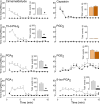Cox-dependent fatty acid metabolites cause pain through activation of the irritant receptor TRPA1
- PMID: 18687886
- PMCID: PMC2575298
- DOI: 10.1073/pnas.0802354105
Cox-dependent fatty acid metabolites cause pain through activation of the irritant receptor TRPA1
Abstract
Prostaglandins (PG) are known to induce pain perception indirectly by sensitizing nociceptors. Accordingly, the analgesic action of nonsteroidal anti-inflammatory drugs (NSAIDs) results from inhibition of cyclooxygenases and blockade of PG biosynthesis. Cyclopentenone PGs, 15-d-PGJ(2), PGA(2), and PGA(1), formed by dehydration of their respective parent PGs, PGD(2), PGE(2), and PGE(1), possess a highly reactive alpha,beta-unsaturated carbonyl group that has been proposed to gate the irritant transient receptor potential A1 (TRPA1) channel. Here, by using TRPA1 wild-type (TRPA1(+/+)) or deficient (TRPA1(-/-)) mice, we show that cyclopentenone PGs produce pain by direct stimulation of nociceptors via TRPA1 activation. Cyclopentenone PGs caused a robust calcium response in dorsal root ganglion (DRG) neurons of TRPA1(+/+), but not of TRPA1(-/-) mice, and a calcium-dependent release of sensory neuropeptides from the rat dorsal spinal cord. Intraplantar injection of cyclopentenone PGs stimulated c-fos expression in spinal neurons of the dorsal horn and evoked an instantaneous, robust, and transient nociceptive response in TRPA1(+/+) but not in TRPA1(-/-) mice. The classical proalgesic PG, PGE(2), caused a slight calcium response in DRG neurons, increased c-fos expression in spinal neurons, and induced a delayed and sustained nociceptive response in both TRPA1(+/+) and TRPA1(-/-) mice. These results expand the mechanism of NSAID analgesia from blockade of indirect nociceptor sensitization by classical PGs to inhibition of direct TRPA1-dependent nociceptor activation by cyclopentenone PGs. Thus, TRPA1 antagonism may contribute to suppress pain evoked by PG metabolites without the adverse effects of inhibiting cyclooxygenases.
Conflict of interest statement
The authors declare no conflict of interest.
Figures




References
-
- Kirtland SJ. Prostaglandin E1: A review. Prostaglandins Leukot Essent Fatty Acids. 1988;32:165–174. - PubMed
-
- Vane JR. Inhibition of prostaglandin synthesis as a mechanism of action for aspirin-like drugs. Nat New Biol. 1971;231:232–235. - PubMed
-
- Bos CL, Richel DJ, Ritsema T, Peppelenbosch MP, Versteeg HH. Prostanoids and prostanoid receptors in signal transduction. Int J Biochem Cell Biol. 2004;36:1187–1205. - PubMed
-
- Narumiya S, Sugimoto Y, Ushikubi F. Prostanoid receptors: Structures, properties, and functions. Physiol Rev. 1999;79:1193–1226. - PubMed
-
- Ferreira SH. Prostaglandins, aspirin-like drugs and analgesia. Nat New Biol. 1972;240:200–203. - PubMed
Publication types
MeSH terms
Substances
Grants and funding
LinkOut - more resources
Full Text Sources
Other Literature Sources
Medical
Molecular Biology Databases
Miscellaneous

